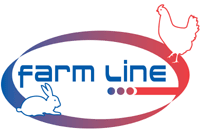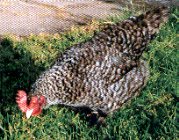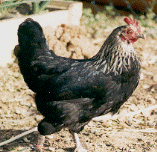

| Sponsors partenaires du MCF, informations et conditions par mail : CONTACT | |||||||
 |
|
 |
|||||
Photos sous licence Creative Commons
type http://creativecommons.org/licenses/by-sa/3.0/deed.fr
CC by sa
|
The Marans bantam |
|
|
| At the breed origin, the
Marans bantam variety didn't exist. Indeed, the Marans
farmers have so only one objective in their farmings : to
perpetuate this productive, rustic, strong farming breed,
its very nice eggs which we wanted to derive a maximun
benefit from for the area.
Of course, such a farming objective has for only valable logic the use of the all breed and not of the bantam breed. Moreover, the majority of the bantam breeds naturally looses most of their economic capacities especially as regards fresh and eggs. But it doesn't constitute by any means the goal to reach for those breeds. There is no use to precise this. |
||
|
|
|
 |
Photos sous licence Creative Commons
type http://creativecommons.org/licenses/by-sa/3.0/deed.fr
CC by sa
On the other hand, the bantam shows all the advantages of its height reduction in the farmings where there is not a lot of place and of the esthetical assets of its dwarfism.
So the bantam Marans bas been created later as well as other breeds and such as all the french breeds.
The bantam Marans remains today too rare but the MCF has many serious farmers and it is advisable to encourage and support them. It is still one of tne MCF objectives.
The problem of a possible approval doesn't enven come up cos the bantam Marans standard must prove to be in every respect, absolutely identical to the tall Marans breed 's.
Only the height and the weight are different of course.
We must remind you at this respect that :
- the required height of the bantam Marans is half the tall breed's.
- the average weight of the adult bantam is 2.20 pounds (i.e 2.4 pounds for the cocks and 1.98 pounds for the hens. instead of 7.27 pounds for the tall Marans breed (8.26 pound for the cocks and 6.39 pounds for the hens).
|
|
|
Photos sous licence Creative Commons
type http://creativecommons.org/licenses/by-sa/3.0/deed.fr
CC by sa
You can noticee in this way that the average weight which is required in the bantam Marans is equal to 30% of the tall Marans breed weight. It makes the bantam breed rather a half-dwarf breed.
Indeed, if we refer to the W.F Entwisle written work, notably quoted by Brandt and Willems, the true "dwarfed" foul weignt (for example Ardenaise or Braekel types) must be one fifth of the tall corresponding breed. In this case, the bantam Marans would have an ideal weight i.e 1.45 pounds. Quite obviously, it is comparable to the true genetic Java or Sebright bantam weight.
We can conclude, in other words, that the preservation of the bantam at their ideal weight is a matter of a constant commintment in the stock selection and that, concerning the initiative of the creation of a new bantam Marans founder, the task would always appear to be long and fastidious.
This initiative can only be recommanded for the bantam amateur farmers who are patient and ready to dedicate at least several years to it.
We should develop below the several types of existing nanism especially the difficulties or the assets which can come up to the bantam Marans amateurs in accordance with the stated cases and knowing that the "true bantam type" of the existing fowls is only really conditionned by the presence of a specific and essential genetic factor.
The non genetic nanism (or the tal breed reduction).
In this case, the bantam poultries are only obtained by a mass drop of the Marans, i.e generated by the only selection of a smaller height of the subjects which are born in the tall Marans breed. In other words, we use a scale to spot the weak subjects…
As the genetic factor of the true genetic nanism (dur serie) was absent, it doesn't take part in this case and obtained dwarfism is relative and what is more it can regularly be questionned.
The mass gap between the work initial weight and the outcome to the bantam height is such that the exploit makes the access chances to a final and regular expected situation more or less uncertain.
So it is a matter, in individual case, of a genetically speaking artificial nanism. Indeed, the atavistic returns don(t fail to provock an unacceptable expansion of these "false" bantam height leading to a regular corrective selection.
We should not forget in this respect that from time immemorial the farmers have always tried to fatten the poultry domestic breed up to 6.61 pounds or 11.02 pounds from the original savage breeds which we relatively small and of course nature tried to take back its rights.
So it's clear that it is still difficult to retain the expected smallness in the bantam founders, but it is all the more difficult to conserve their minimal masses in the stock of a good many heavy poultries (including the tall Marans breed).
The problem is of the same kind. In reality, it's always this "unnatural" fight which prevails as wall as in the search of an abnormally great height of some breeds as in the search of an animal abnormally small height like bantam breeds among which appears the Marans.
In this way, in the "hen genetics" of the French Bantam Club, J.C Martin writes that if we want to dwarf a tall breed, it is advisable never to use more reductions of great breed but rather to use real bantam breeds.
Inthis way, we speak of the "real nanis" of the poultries when it is about the incontestable presence in thei genotype of some identified and precise hereditary characteristics which cause a truly very small heignt in the founders. The Sebright case is an excellent current example.
This characteristic was discovered in a Loghorn stock in 1973 and reduced the subject mass of about 30% from the age of 6 or 8 weeks, as well as the eggs. It is due to an autosomic and recessive gene that we call (adw).
Today, we won't know if the gene interests somehow most of the various present bantam breeds.
The nanism linked to sex (dw) serie
Different alleles, all responsible for a nanism type, have been revealed from 1949, that is the (dw), (dwa), (dwd), (dwM), (dwB) genes as well as the (Dw+) gene which has been recognized as responsible for the poultry usual and normal height. The differences between the remain vague, uncertain and only concern non essential details linked to the relative smallnee of the different heights and tarsus.
The (dwB) characteristic is the one which interests us in the individual case because it appears that it's this characteristic which causes the present breed "real" nanism such as well-known Sebright or even Java, bantam belgian and other real genetic bantam hens. This factor is a recessive gene linked to sex. So it is going to disappear visually, at least partly, in first generation, in a crossing with the great Marans breed.
All the true existing bantam breeds are so made up of one of the factors responsible for the nanism, notably (dwb) which would anyway be recessive in the genotype.
Reconstitution of a bantam founder.
The means
In order to obtain a new founder of the true bantam Marans, there are only three existing means:
1. Fortuitous mutation
- to wait eternally that a true bantam mutation comes into being in the great Marans breed founders. This mean applied by a risky natural mutation shouldn't leave any hope as for the uncertain and ridiculous chances of success that it presents. I wouldn't count on it. Let's forget !
2. Priority to the nanism
- to marry together two different breeds of true existing bantams in the exterior breeds and gradually get closer by the selection of the ideal Marans type … as well as the color of its extra reddish-brown eggs.
This solution shows on by one real asset : to keepeasily the "ture bantam" characteristic looked for in the stocks because it's recessive and to deplore only few problems concerning the expansion danger of the subjects. The stability of the dwarfstate is safeguarded.
Furthermore, the fact to hope a bantam Marans in the end by crossings of other bantam breeds which have at the beginning nothing in common with the Marans, is an exploit and appears to be utopia to say the least (and how would we produce the essential extra reddish-brown characteristic of the egg ?) Let's forget too !
This selection, considering the obligatory genes to be gathered in a Marans, is inaccessible and an illusion !
3. Crossings of great breed Marans with the bantam variety
- To bring to this tall breed Marans the genetic factor of the essential nanism (dwb) by crossing of real existing bantam fowls with them. These bantams must be, as far as possible, close in color, in egg color (reddish-brown) and in type.
Moreover, we could sometimes attempt to use other means not very kesher to reduce the poultry height in the years to come. For example, by making the hens brood small eggs very late in the season, to give short rations in order to weaken the breeding stock or the young animals to obtain a relative nanism.
This initiative can lead in the end to some disappointments because here again, the subject's genotype remains unchanged and that consequently nature regularly tends to take back its rights.
This third solution seems to be more conceivable and this is due to the following reason :
The introduction of a pure Marans subjects in a crossing with bantam give the opportunity, from the beginning of the selection and theorically, to set the heredity of the Marans breed characteristics, including the extra reddish-brown eggs, but however not without difficulties to maintain them scrupulously combined.
So according to some experiments, it seems that this selection of the ideally researched dwarf height was made more difficult due to the fact that the bantam subjects of these crossings still keep an atavistic tendancy to grow. It obliges in the selection to make an almost constant follow up of the true nanism in its ideal state but however these difficulties seem to have no common measures with those that the non genetic nanisation attempts, wich are exhibited above, would show.
This characteristic is usual for a good many of bantam farmings which, as we know, must fight to maintain the recommanded smallness of the height. Moreover, to question the bantam farmers themselves as well as the official judges which watch them everyday is sufficient to be convinced of it.
The principle consists in choosing a tall breed Marans cocks in the following way :
Seeked requirements and purposes :
We consider, in accordance with the experiments made from 1949, that the bantam breeds used from the beginning are all affected by a (dw) gene which is on the one hand recessive and on the other hand linked to sex.
By the crossing of a tall breed Marans cock (which is not to heavy) with true bantams, we will obtain heterozygous subjects notably some cocks, i.e subjects which are simply carrier in the latest state of the coveted genetic factor : the (dwB) nanism. We won't keep the hens.
It is not disturbing and genetically without importance at this stage that the obtained heterozypous cocks could appear to have variable height because thei "absence of nanism (Dw+) gene is an incomplete dominating factor and so partly influenced by the latest nanism (dwB). The choice must however be made on the smaller cocks because it is always advisable to facilitate the couplings with bantam hens.
Of course, it is essential to select some of the among the subjects which are the most conform to the Marans type knowing that at this level of the selection the hereditary "extra reddish-brown egg quality" already slips through our fingers.
The most typical and heterozygous cocks must be associated with some bantam hens (thei mother for example) in order to obtain in second generation, some heterozygous cockerels, some great breed pullets, some real bantam cockerels and some real bantam pullets each for about a quarter.
These two latters categories can finally be coupled in consanguinity to constitute some theorically pure bantam stocks but pure as for the only nanism (dwB) gene.
1- The egg color must be tested on the second generation bantams because they determine a passing on or not of the extra reddish-brown characteristic coming from thei fathers.
As it were, we start an essential selection between the different used fathers as for the egg quality of all the obtained females.
According to these elements, we can eliminate the cocks designated as having, at first sight and theorically no hereditary potentiality for the extra reddish-brown egg and so eliminate thei rwhole tested descendance.
2- The bantam Marans obtained from these couplings are theorically of only a quarter of Marans breed blood It shows how the difficulties would be numerous when it would be a question of eliminating the undesirable genes coming from exterior breed bantams of the beginning, of joining moreover the essential and typical characteristics of the Marans, i.e notably :
Some requirements of great patience, time, place, and passionate adventurer quality seem to be vital for the amateur farmers who want to nanify correctly a great existing breed.
|
Use of existing bantam Marans: |
 |
The bantam Marans still remains very rare today but we can find it in the Brown-red, Birchen, silver-cuckoo, wheat colored, Buff columbian, Black-red…
The use of such subjects makes the bantam Marans selection more attainable but only on the condition that the used bantams are true genetic bantams with the presence of the (dwB) factor.
Moreover, it seems that some existing bantams old simultaneously some flaws concerning the too light egg color or also concerning the general bodyform which is still a little too much a typical of the Marans
The form of the head, back, tail for example or simplier the general posture are still insufficiently similar to the breed's which reinforced the farmer's merit in their bantam selection work.
Finally, in the difficult cases, nothing must prevent from having recourse to a "requenching" with some great breed Marans cock by the previously describded means.
This selection types turns out to be a little less problematic in comparison with the cases of the use of the bantams different from the Marans.
THE OFFICIAL VARIETIES OF THE CURRENT STANDARD
|
Silver-cuckoo Variety |
|
OTHER VARIETIES NOT APPROVED YET